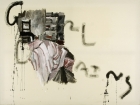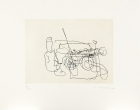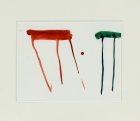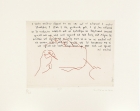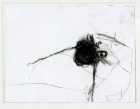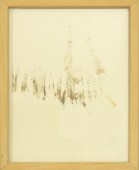
Artist | Miquel Barceló (*1957)
https://www.artist-info.com/artist/Miquel-Barcelo
Biography
Biography
Miquel Barceló was born in 1957 in Felanitx, Mallorca.
After studying at the Arts and Crafts School of Palma de Mallorca for two years, he enrolled in 1974 at the Fine Arts School of Barcelona.
In 1975 he returned to Mallorca, where he joined the conceptual group "Taller Lunatic".
The following year he had his first one-man show at the Museo Mallorca in Palma.
In the 1980s and 1990s, he travelled extensively across Europe, USA and West Africa.
His work has been subject to numerous exhibitions in European and American museums and galleries. These include La Caixa, Madrid 1981; CAPC, Bordeaux 1985; Palacio de Velazquez, Madrid 1985; Städtische Galerie im Lenbachhaus, Munich 1985; ICA, Boston 1986; Antic Teatro de la Casa de la Caritat, Barcelona 1987; Musée d'Art Contemporain, Montreal 1988; Carré d'Art, Nîmes 1991; Galleria Civica d'Arte Contemporanea, Trento 1993; Whitechapel Art Gallery, London 1994; IVAM, Valencia 1995; Galerie nationale du Jeu de Paume, Paris 1996; Centre George Pompidou, Paris 1996.
Barceló designed the costumes and stage-sets for Manuel de Falla's opera "Tréteaux de Maître Pierre" at the Opera Comique in Paris in 1990.
He is the youngest artist to have shown a work at the Louvre, and the only artist to have exhibited simultaneously at the Centre Pompidou (works on paper) and the Jeu de Paume (paintings and sculpture).
Barceló currently divides his time between Paris, Mali and Mallorca.
The exhibition (April - May 1998) at Timothy Taylor Gallery London consists of selected works influenced by or made during one of his many trips to Mali, West Africa.
About the work (english)
About the work (english)
STUDIO TALK by John Berger
A scrap of paper crumpled up and thrown on the studio floor amongst unstretched canvasses on which you stand, pails of pigment - some mixed with clay, the odd saucepan, broken sticks of charcoal, rags, discarded drawings, two empty cups. On the scrap of paper are written two words: FACE and PLACE.
The studio was once a bicycle factory, no? You work here in your painting shoes and clothes. The shirt and trousers were originally striped. Now, like the shoes, they are encrusted with pigment. So I picture you as two people: a man about to ride away on his bicycle and a convict.
However, the only thing which matters, when the day is done, is what lies painted on the floor or leaning against the walls, waiting to be seen the next day. What matters is what the changing light can never quite reveal - the thing, to which one is nearest, when one fears one has probably lost it.
*
FACE. Whatever the painter is looking for, he's looking for its face. All the search and the losing and the re-finding is about that, isn't it? And "its face" means what? He's looking for its return gaze and he's looking for its expression - a slight sign of its inner life. And this is true whether he's painting a cherry, a bicycle wheel, a blue rectangle, a carcass, a river, a bush, a hill or his own reflection in a mirror.
Photos, videos, film never find the face; at their best they find memories of appearances and likenesses. The face, by contrast, is always new: something never before seen and yet familiar. (Familiar because, when asleep, we dream of the face of the whole world, into which at birth we were blindly thrown.)
We see a face only if it looks at us. (Like Vincent's sunflower.) A profile is never a face, and cameras turn all faces into profiles.
When we have to stop before a finished painting, we stop as before an animal who is looking at us. Yes, this is ever true for Antonello de Messina's "Pieta with an Angel". The paint laid or brushed or smeared on to the surface is the animal, and its "look" is its face. Think of the face of Vermeer's "View of Delft". Later the animal may hide, but it's always there when it first stops us and won't allow us to go on.
An old story that goes back to the caves.
*
PLACE. Place in the sense of lieu, luogo, ort, mestopolojenie. The last Russian word also means situation and this is worth remembering.
A place is more than an area. A place surrounds something. A place is the extension of a presence or the consequence of an action. A place is the opposite of empty space. A place is where an event has or is taking place.
The painter is continually trying to discover, to stumble upon, the place which will contain and surround his present act of painting.
Ideally there should be as many places as there are paintings. The trouble is that a painting often fails to become a place. When it fails to become a place, a painting remains a re-presentation or a decoration - a furnishing.
How does a painting become a place? It's no good the painter looking for the place in nature - it wasn't in Delft that Vermeer found it!
Nor can he search for it in art - because, despite the belief of certain post-modernists, references don't make a place. Where a place is found it is found somewhere on the frontier between nature and art. It is like a hollow in the sand within which the frontier has been wiped out. The place of the painting begins in this hollow. Begins with a practice, with something being done by the hands, and the hands then seeking the approval of the eye, until the whole body is involved in the hollow. Then there's a chance of it becoming a place. A slim chance.
Two examples. In Manet's "Olympia" the hollow, the place, (which of course has nothing to do with the boudoir in which the woman is lying) began in the folds of the bed-cover by her left foot.
In a drawing by you of a mango and a knife - they are black and about life-size on a sheet of yellowish paper on to which dust has blown - the place began when you lay the fruit in the curve of the knife's blade. The paper became its own place at that moment.
*
The Renaissance notion of perspective, with its predilection for an outside view point, hid for many people during several centuries the reality of painting-as-place. Instead, a painting was said to represent the "view" of a place. Yet this was only theory. In practice the painters themselves knew better. Tintoretto, great late master of perspective, turned the theory on its head time and again.
In his "Carrying of the Body of Saint Mark" the painting as place has nothing to do with the perspective of the immense piazza with ist arcades and marble paving stones, and everything to do with the haphazard pile of logs in the middle distance on which the saint was going to be cremated. From the brush strokes of those painted branches of wood everything else on the canvas stems - the fleeing figures, the camel's coat hair, the lightening in the sky, the saint's foreshortened limbs... Or, to put it another way, it is from the wood pile that the web of the whole colossal painting was spun.
And since Jacopo Robusti pursues us both as Tintoretto, here is another example. In his London "Susannah and the Elders" the painting-as-place did not begin with her incomparable body or with the artful mirror or with the water coming up to her knee, no, it began in the strange artificial flowering hedge which she is facing and behind which the Elders hide. When Jacopo, with a full brush, began touching the hedge's flowers, he was arranging the place to which everything else had to come. The hedge took over as host and master.
Working alone, the painter knows that far from being able to control the painting from the outside, he has to inhabit it and find shelter in it. He works by touch in the dark.
In your studio the light, towards evening, changes, and the canvasses change more than anything else which can be seen. (Far more than the crumpled paper with the words). Exactly what changes in them? It is hard to say. Their temperature perhaps and their air pressure. For they do not change in this light like paintings. Each changes like a familiar terrain outside a door. Like places.
*
How does a painter work in the dark? He has to submit. Often he has to turn around in circles instead of advancing. He prays for collaboration from somewhere else. (In your case from the wind, the termites, the desert sand.) He builds a shelter from which to make forays so as to discover the lie of the land. And all this he does with pigment, brush strokes, rags, a knife, his fingers. The process is highly tactile. Yet what he is hoping to touch is not normally tangible. This is the only real mystery. This is why some - like you - become painters.
When a painting becomes a place, there is a chance that the face of what the painter is looking for will show itself there. The longed-for "return look" can never come directly to him, it can only come through a place.
If the face does come, it is partly pigment, coloured dirt: partly drawn forms always being corrected: but, most importantly, it is the becoming, the coming-towards-being of what he was searching for. And this becoming is not yet - and, in fact never will be - tangible, just as the bison on the walls of the canvas were never edible.
What any true painting touches is an absence - an absence of which, without the painting, we might be unaware. And that would be our loss.
The painter's continual search is for a place to welcome the absent. If he finds a place, he arranges it and prays for the face of the absent to appear.
As you know, the face of the absent can be the backside if a mule! There are no hierarchies, thank God.
*Has something been saved?
This time, yes.
What?
A part, Miquel, of what begins again and again.
Solo Exhibitions (selection)
Solo Exhibitions (selection)
1974 Dibujos de insectos y moluscos, Casa de la Cultura de Manacor (Mallorca)
1976 Cadaverina 15, Museo de Palma de Mallorca
1977 Galeria 4 Gats, Palma de Mallorca
1978 Galeria Sa Pleta Freda, Son Servera (Mallorca)
1981 30 libros pintados y un libro de hierro, Galeria Metronom, Barcelona
1982 Colegio de Arquitectos, Palma de Mallorca
1982 Miquel Barceló, Galeria Trece, Barcelona (Catalogue)
1982 Galería Fúcares, Almagro (Spain)
1982 Pintagossos, Axe Art Actuel, Toulouse (Catalogue)
1983 Med-a Mothe, Montpellier
1983 Galleria Lucio Amelio, Naples
1983 Galerie Yvon Lambert, Paris
1984 Galerie Bruno Bischofberger, Zurich
1984 Pinturas 1984, Galería Juana de Aizpuru, Madrid (Catalogue)
1985 Galerie Zwirner, Cologne
1985 Galerie Bruno Bischofberger, Zurich
1985 New Paintings, Akira Ikeda Gallery, Nagoya (Catalogue)
1985 - 86 Miquel Barceló - Peintures de 1983 à 1985, CAPC, Bordeaux, travelling to: Palacio de Velázquez, Madrid (Catalogue), Institute of Contemporary Art, Boston (Catalogue)
1986 Leo Castelli Gallery, New York
1986 Thomas Segal Gallery, Boston
1986 Miquel Barceló - Drawings 1985, Anders Tornberg Gallery, Lund (Sweden) (Catalogue)
1987 Galerie Yvon Lambert, Paris
1987 Miquel Barceló, Galerie Michael Haas, Berlin (Catalogue)
1987 Miquel Barceló, Waddington Galleries, London (Catalogue)
1987 NouArt Galeria, Palma de Mallorca
1987 Leo Castelli Gallery, New York
1987 Galeria Eude, Barcelona
1987 - 88 Barceló, Barcelona - Pintures de 1985 a 1987, L’Antic Teatre de la Casa de la Casa de la Caritat, Barcelona (Catalogue)
1988 Miquel Barceló - Peintures recéntes, Musée d’Art Contemporain de Montréal (Catalogue)
1988 New Paintings, Galerie Bruno Bischofberger, Zurich
1989 Miquel Barceló, Galleria Lucio Amelio, Naples (Catalogue)
1989 Miquel Barceló in Mali - Papers from Africa, Galeria Dau al Set, Barcelona (Catalogue)
1989 Paintings, Leo Castelli Gallery, New York
1989 Drawings and Prints, Leo Castelli Gallery, New York
1990 Miquel Barceló - Obra 1989, Galería Soledad Lorenzo, Madrid (Catalogue)
1990 Waddington Galleries, London (Catalogue)
1990 Galerie Yvon Lambert, Paris
1991 Toros, Galerie Bruno Bischofberger, Zurich (Book)
1991 Miquel Barceló, Musée d’Art Contemporain de Nîmes (Catalogue)
1992 Miquel Barceló - Obra 1991, Galería Soledad Lorenzo, Madrid (Catalogue)
1992 Pièce Unique, Ameliobrachot, Paris (Catalogue)
1992 Miquel Barceló, First Gallery, Moscow (organized by Galerie Bruno Bischofberger, Zurich (Catalogue)
1992 Miquel Barceló, Galería Salvador Riera, Barcelona (Catalogue)
1992 Miquel Barceló, Gana Art Gallery, Seoul (Catalogue)
1992 De Rerum Natura, Leo Castelli Gallery, New York
1993 New Works, Galerie Bruno Bischofberger, Zurich
1993 Miquel Barceló - Desenhos - Pinturas - Esculturas, Galeria Nasoni, Porto (Portugal) (Catalogue)
1993 Miquel Barceló, Galleria Civica di Arte Contemporanea, Trento (Catalogue)
1993 Drawings from Mali, Kunsthal Rotterdam
1994 Miquel Barceló, Pinturas y Esculturas 1993, Galería Soledad Lorenzo, Madrid (Catalogue)
1994 Miquel Barceló - 1984-1994, Whitechapel Art Gallery, London (Catalogue), travelling to: Ivam Centre del Carme, Valencia (Catalogue)
1994 - 95 Miquel Barceló: Recent paintings & sculptures, Kyoto Chirathivat Gallery, Bangkok (Catalogue)
1995 Miquel Barceló - Sculptures and paintings, Leo Castelli Gallery, New York
1995 Miquel Barceló - Portraits, Galerie Bruno Bischofberger, Zurich
1996 Miquel Barceló/Miquel Barceló - impressions d’Afrique 1988-1995, Galerie Nationale du Jeu de Paume et Musée national d’art Moderne, Centre Georges Pompidou, Paris (Catalogue)
1996 Miquel Barceló - Estampes, Galerie Lucie Weill-Seligmann, Paris
1996 Miquel Barceló - Malerier - Skulpterer, Galleri Haaken, Oslo (Catalogue)
1997 Stillevens, PMMK, Museum voor Moderne Kunst, Ostende (Belgium) (Catalogue)
1997 Miquel Barceló, Château de Chenonceau, Chenonceau, France
1997 Miquel Barceló, Centro Cultural Recoleta, Buenos Aires (Catalogue)
1997 Miquel Barceló, Galería Soledad Lorenzo, Madrid (Catalogue)
1998 Miquel Barceló, Timothy Taylor Gallery, London (Catalogue)
Group Exhibitions (selection)
Group Exhibitions (selection)
1977 Galeria Mec-Mec (Neon de Suro), Barcelona
1981 Biennial, São Paulo, Brazil (Catalogue)
1981 Otras Figuraciones, Fundació "la Caixa", Madrid
1982 Documenta 7, Kassel
1982 26 pintores, 13 criticos, Fundació "la Caixa", Barcelona (Catalogue)
1982 Libros de artista, Salas Pablo Ruiz Picasso, Madrid
1983 Evrospka & Ameviska, Yugoslavia
1983 Transformations, Arca, Marseille
1983 La Bienal Artes Plastica, Spain
1983 La Imagen del animal, Casa de las Alhajas/Caja de Ahorros, Madrid
1983 Annina Nosei Gallery, New York
1983 Identitats, Sala de la Caixa de Pensiones, Barcelona
1984 En el centro, Centro Cultural de la Ciudad de Madrid
1984 XLI Biennial, Venice (Catalogue)
1984 An International Survey of Recent Painting and Sculpture, Museum of Modern Art, New York (Catalogue)
1984 Art Espagnol Actuel, Toulouse travelling to: Fontevraud, Strasbourg, Nice
1984 La presencia de la realidad en el arte español, Madrid
1985 7000 Eichen, Kunsthalle Tübingen and Kunsthalle Bielefeld
1985 5 Spanish Artists, Artist’s Space, New York (Catalogue), travelling to: Europalia and Gent, Belgium (Catalogue)
1985 Rudolf Zwirner, Cologne
1985 Biennial, Paris (Catalogue)
1986 Barcelone, art contemporain, Centre d’échange de Perrache, Lyon
1986 Saura, Arroyo, Sicilia, Barceló, Museum of Modern Art, Oxford (Catalogue)
1986 Pintores y Escultores Españoles 1981-1986, Fundación Caja de Pensiones, Madrid
1986 Zehn Maler aus Spanien, Kunstverein, Hamburg
1986 A propos de dessin, Galerie Adrien Maeght, Paris
1986 The Biennial of Sydney (Catalogue)
1986 Heads, Nicola Jacobs Gallery, London
1986 Prospekt 86, Kunstverein Frankfurt
1986 Galeria Dau al Set, Barcelona
1986 Institute of Contemporary Art, Boston
1987 Paisatges, Conselleria d’Educació y Cultura del Govern Balear, Sa Llonja (Palma) (Catalogue)
1987 L’Imagination Nouvelle - Les Années 70-80, Musée d’Art Moderne de la Ville de Paris (Catalogue)
1988 Galería Marga Paz, Madrid
1988 Galerie Beaubourg I and II, Paris
1988 Colectiva 1, Galeria Berini, Barcelona
1988 Miquel Barceló, George Condo, Julian Schnabel, Galería Soledad Lorenzo, Madrid (Catalogue)
1988 España, Monterrey Peninsula Museum of Art, San Francisco
1988 Les années 80: A la surface de la peinture, Centre d’Art Contemporain,
1988 Abbaye Saint-André, Corrèze, Meymac (France) (Catalogue)
1988 Prints of Tàpies, Miró, Barceló, Chillida, Galeria Eude, Barcelona
1988 Exhibition to benefit the Karole Armitage Ballet, Galerie Bruno Bischofberger, Zurich
1988 Antoni Tàpies, Miquel Barceló, José Maria Sicilia, Galerie Natalie Seroussi, Paris (Catalogue)
1989 Primavera, Galeria d’Art Disset, Barcelona
1989 Spain Art Today, The Museum of Modern Art, Takanawa, Karuizawa, Japan (Catalogue)
1989 Wetiner Diwan / Sigmund Freud heute, Museum des 20. Jahrhunderts, Vienna (Catalogue)
1990 Colección Fin de Siglo, Galería Almirante, Madrid
1990 Les Années 80 - Enquête de leurs ombres, Centre Régional d’Art Contemporain Midi-Pyrénées (France) (Catalogue)
1990 PHARMAKOM 90, Makuhari, Contemporary Art Exhibition
1991 Constantes del arte Catalán actual, Museo Rufino Tamayo, Mexico (Catalogue)
1991 Nature - Création du peintre, Musée Cantonal des Beaux-Arts, Lausanne (Catalogue)
1991 Fons d’Art, Espais Centre d’Art Contemporaini, Girona
1991 Point de vue, Espace Cordeliers, Lyon
1991 Galleri Faurschou, Copenhagen (Catalogue)
1991 Al aire de su vuelo, Pabellón de Mudéjar, Sevilla (Catalogue)
1992 Criatures Misterioses, Fundació "la Caixa", Barcelona (Catalogue) travelling to: Fundación "la Caixa", Gerona, Fundación "la Caixa", Madrid
1992 Espagne - 23 Artistes pour l’An 2000, Artcurial, Paris (Catalogue)
1992 Taureaux en tête, Galerie Georges Pompidou, Anglet (France) (Catalogue)
1992 Le Portrait dans l’art contemporain, Musée d’Art Moderne et d’Art Contemporain, Nice
1992 Werkformen, Galerie Karl Pfefferle, Munich (Catalogue)
1992 Copier, créer. De Turner à Picasso: 300 oeuvres inspirées par les maîtres du Louvre, Musée du Louvre, Paris
1992 Allor si moose, e io li tenni diertro, Galleria Lucio Amelio, Naples
1994 El autoretrato en España, Fundación cultural Mapfre, Madrid
1994 L’incanto e la trascendenza, Castel Ivano, Trento (Italy) (Catalogue)
1995 Premio Marco, MARCO Museum, Monterrey, Mexico
1996 Picasso. A Contemporary dialogue, Galerie Thaddaeus Ropac, Salzburg (Catalogue)
1997 Papiers contemporains, Galerie Jérôme de Noirmont, Paris
1997 La sculpture des peintres, Fondation Maeght, Saint-Paul-de-Vence (France) (Catalogue) 18th March - 25th April 1998
Exhibition at IVAM, Valencia
Exhibition at IVAM, Valencia
Miquel Barceló (Photography by Jean-Marie del Moral)
IVAM Centre Julio González
20 January – 21 March, 2004
Curator: Alberto Anaut
The exhibition will comprise some 80 photographs taken between 1985 and the present day by the Franco-Spanish photographer Jean-Marie del Moral, who accompanied Miquel Barceló as a travelling companion on his adventures. From Paris to Barcelona, from Palermo to Gao, from Farrutx in Majorca to Segou, Del Moral has elaborated a colourful biography of the artist's life through his studios, his objects, dozens of little details that make up his complex universe. All these photographs that could be defined as a travel book and allow us to see the personal and artistic evolution of the Spanish artist most acclaimed on an international scale, who has recently been awarded the Premio Príncipe de Asturias for Art.
Besides, a 26-minute video titled Les ateliers de Barceló will be shown, a series of animated black and white photographs that constitute a travel book around the Majorcan artist's different studios during the seven years before it was made in 1992.
The exhibition revolves around several series titled according to the place and the year they were taken: Avenue de Breteuil 1985, Cúpula Barcelona 1988, Farrutx 1987-1988, Gao 1988, Segou 1991, Pays Dogon 2000, Buttes Chaumont 1989-90, Opera Comique 1989, Palermo 1998, Les Rairies 1999-2000, Lanzarote 2002, Rue Vieille du Temple 1992-2002. These series, which show Barceló's evolution in time and work, recreate a painter's path with its twists and turns, its doubts and its searches, the traces of his memory of places and time.
When he met Miquel Barceló in his studio in Paris back in 1985, while he was preparing his first exhibition at the Castelli Gallery in New York, Jean-Marie del Moral had no way of knowing he was about to embark on an extraordinary voyage that would turn him into a privileged witness of the life and creative development of that unknown young painter, who has attained great fame today. The photographer felt the same sensation that he had experienced some years earlier when he entered the studio of another great painter, Joan Miró: an authentic revelation that changed his career and transformed him from a news reporter to a chronicler of contemporary art. Then he met Antonio Saura, Miguel Ángel Campano, Antoni Clavé, Baltasar Lobo and many other artists.
The result of his work, now exhibited at the IVAM, has been published in the catalogue Los estudios de Barceló, which gives us an opportunity to see not only the work but also the human being who observes and transforms what he sees into art. Two glances that have travelled together over two decades for our enjoyment.
JEAN-MARIE DEL MORAL.- Born in France in 1952, the son of Spanish republican exiles, Jean-Marie del Moral has trained his camera on the private studios of important painters, a world that has fascinated him since he first met Joan Miró in 1977. His great collection of pictures conforms an intense exploration of the private creative universes of many painters of international repute, including, apart from Miró, Sam Szafran, Soulages, Fenosa... The resulting pictures show naked or sophisticated interiors, but always concerned with his preoccupation for the object, the decoration and artists in the midst of their crowded studios concentrating to the limits of their inspiration.
Jean-Marie del Moral's photographic work can be found in both public and private collections all over the world. His pictures of Barceló were shown for the first time at the international exhibition in Arles, France, in 1988. He has published books on the studios of Miró, Picasso and Van Gogh, and is a well-known collaborator of Vogue, Travel & Leisure, World of Interiors, Art Kunstmagazin, El País, Beaux Arts, The Observer, Time and Figaro Madame, among other publications. He has also made several documentaries, like Ram Dam, for the French Canal 3 or a series of portraits of artists: Pierre Soulages, Yvon Lambert, Richard Texier, Mariscal, Manuel Vázquez Montalbán, Picasso and things and, in 1992, Barceló's studios. His work as a photographer has been shown in a series of important exhibitions, such as Los tiempos de la pintura in the Musée Donjon, in Niort (1987), or the one held a year later at the Galería Eude in Barcelona. In 1989 he exhibited at the International Photography Encounters in Arles and he has been present at the FIAC through the Catalan gallery Carles Taché. He has published various books of photographs, among which it is worth mentioning Photographies, brought out by the Association L'Oeil.
At the present time, he dedicates himself to photography, the publication of books and the making of documentaries.
 offers / Requests offers / Requests  |
Learn more about this service |
|---|
 Exhibition Announcements Exhibition Announcements  |
About this service |
|---|
 Visualization |
Learn more about this service | ||
|---|---|---|---|

Interested in discovering more of this artist's networks?
3 easy steps: Register, buy a package for a visualization, select the artist.
See examples how visualization looks like for an artist, a curator, or an exhibition place: Gallery, museum, non-profit place, or collector.

Exhibition History

|
SUMMARY based on artist-info records. More details and Visualizing Art Networks on demand. Venue types: Gallery / Museum / Non-Profit / Collector |
||||||||||||
| Exhibitions in artist-info | 66 (S 31/ G 35) |
Did show together with - Top 5 of 885 artists (no. of shows) - all shows - Top 100
|
||||||||||
| Exhibitions by type | 66: 43 / 12 / 11 / 0 | |||||||||||
| Venues by type | 44: 25 / 10 / 9 / 0 | |||||||||||
| Curators | 12 | |||||||||||
| artist-info records | Oct 1981 - Apr 2016 | |||||||||||
|
Countries - Top 5 of 9 United States (13) France (13) Spain (10) United Kingdom (10) Germany (9) |
Cities - Top 5 of 28 New York (11) London (10) Köln (6) Paris (6) Saint-Paul-de-Vence (3) |
Venues (no. of shows )
Top 5 of 44
|
||||||||||
Curators (no. of shows)
Top 5 of 12
|

Miquel Barceló - Ceramics |
||||||
| Galerie Ropac - Paris Marais | S | Mar 2016 - Apr 2016 | Paris | (106) | +0 | |

Miquel Barceló - L'Inassèchement |
||||||
| Galerie Ropac - Paris Marais | S | Apr 2015 - May 2015 | Paris | (106) | +0 | |

Le peintre et l'arène - Art et tauromachie, de Goya à Barceló |
||||||
| Musée d'art moderne de Céret | G | Jun 2014 - Oct 2014 | Créet | (119) | +0 | |
| Friedman Benda | S | Oct 2013 - Dec 2013 | New York | (4) | +0 | |

Miquel Barceló - Terra Ignis - Céramiques, Majorque 2009-2013 |
||||||
| Musée d'art moderne de Céret | S | Jun 2013 - Nov 2013 | Créet | (119) | +0 | |

MOVING - Norman Foster on Art |
||||||
| Carré d’art - Musée d’art Contemporain | G | May 2013 - Sep 2013 | Nîmes | (118) | +0 | |
| Foster, Norman (Curator) | +0 | |||||
| Keep reading |
















